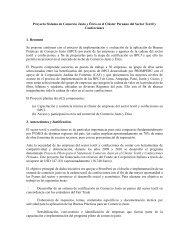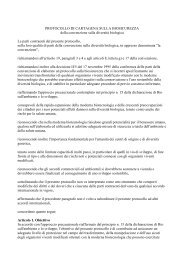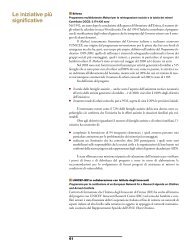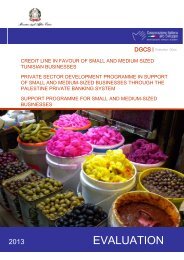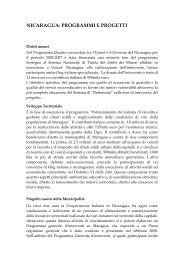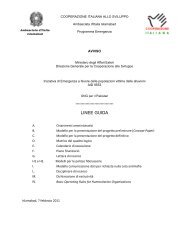FRONTESPIZIO - Cooperazione Italiana allo Sviluppo
FRONTESPIZIO - Cooperazione Italiana allo Sviluppo
FRONTESPIZIO - Cooperazione Italiana allo Sviluppo
You also want an ePaper? Increase the reach of your titles
YUMPU automatically turns print PDFs into web optimized ePapers that Google loves.
72 Carlo Resti, Yohannes Tadessewith service needs and objective realities in terms of the training of high levelprofessionals. In particular, there is a serious problem in terms of the deploymentof physicians within the public sector, especially to rural areas.Practice regulation is almost non-existent, particularly for those within theprivate sector.Attrition and Brain Drain due to migration abroadThe problem of brain drain in African countries is multi-dimensional. Onesuggested typology of this problem is to see it as “soft” and “hard” braindrain 5 . Loss of knowledge due to unavailability of health research results tohealth practitioners in Africa because many African researchers prefer to publishin northern journals can be considered as “soft brain drain”, while physicalmovement of health personnel from developing countries to northerncountries can be counted as “hard brain drain”.Among the “push” factors contributing to brain drain are: low salaries andbenefits, fear of occupational infections where HIV/AIDS and other infectiousdiseases are rife, lack of well equipped physical infrastructure, drugs, suppliesand good health management system, inadequate research possibilitiesand lack of opportunity to keep up-to-date with information in their field.In addition to the factors that are pushing health professionals out of thecountry, conditions in and practices of high-income countries (“pull” factors)encourage them and contribute to their ability to work abroad.Brain drain is a relatively recent phenomenon in the Ethiopian health sectorworkforce. Prior to 1974, Ethiopia’s skilled professionals neither emigratednor decided to stay on in the countries of their training in search of betterworking conditions and for fear of political persecutions. With the advent ofan increasing number of push factors, however, this trend has changed overthe past couple of decades. About 50% of Ethiopians who went abroad andcompleted their studies did not return home during the past 10-15 years. Forinstance, between 1980 and 1991 only 5,777 students out of a total of22,700 returned home 6 .5 Muula A. Is there any solution to the “Brain Drain” of health professionals and knowledgefrom Africa? Croat Med J 2005 46(1): 21-29.6 Mengesha Y and Kebede Y. Brain Drain. In Berhane Y, Haile Mariam D, Kloos H. TheEpidemiology and Ecology of Health and Diseases in Ethiopia. SHAMA Books andEthiopian Public Health Association, Addis Ababa, Ethiopia (1 st edition 2006).





